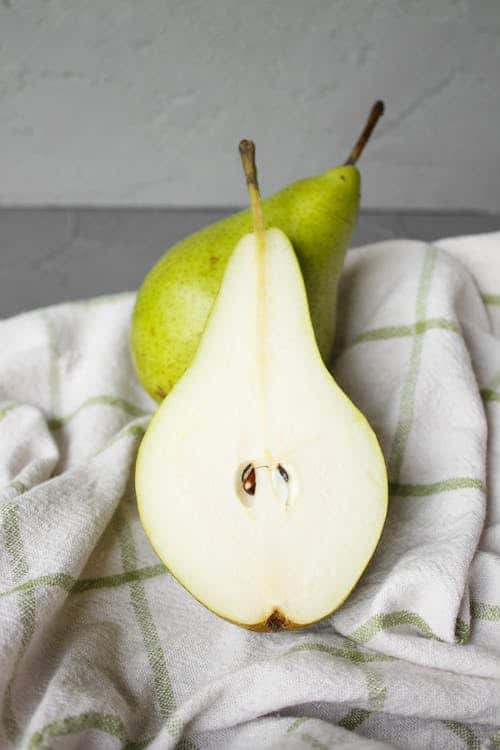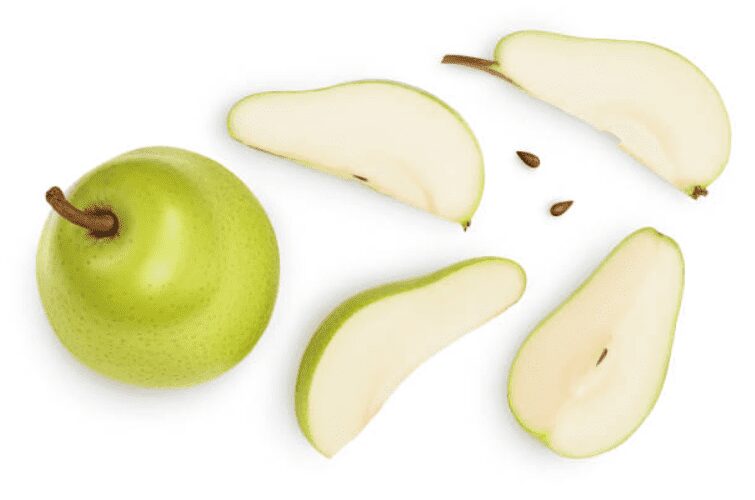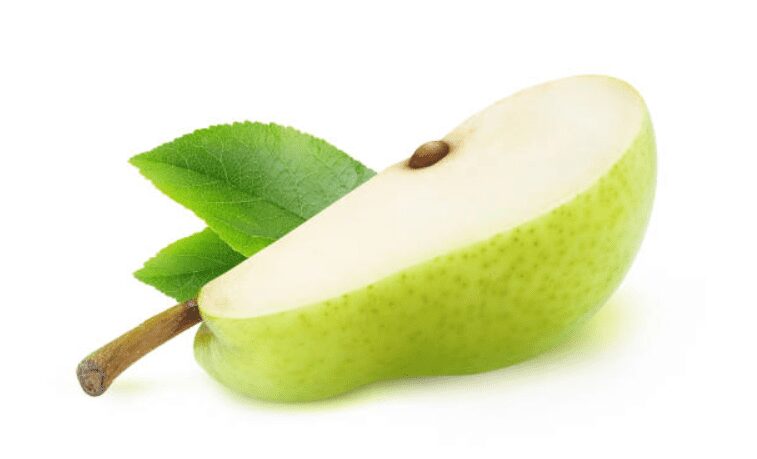Pears are a delicious and nutritious fruit that can be enjoyed in many different ways. Unfortunately, when pears are cut, they tend to turn brown quickly. This is due to the enzymes phenolase and phenols in their tissue reacting with oxygen when exposed to air.
This process is known as oxidation and results in the discoloration (browning) of the pears on the side that’s cut. Although brown pears are still safe to eat, they may not look or taste as pleasant as fresh ones.
Fruits contain enzymes that help with the ripening process, and this is especially true for pears which contain higher levels of these enzymes than other fruits.
When you cut a pear in half or slice it, you expose its cells and the enzyme comes into contact with oxygen, causing it to oxidize and turn brown. In this post, we’ll share ideas on how to keep pears from turning brown, and how to prevent this from happening.
How To Keep Pears From Turning Brown

The dreaded browning of sliced pears is a common problem faced by many. Not only do they look unappetizing, but the browning also affects the texture of the fruit, making it less crisp and juicy. Fortunately, there are several ways to keep your pear slices from turning brown.
Each method has its own pros and cons so you can choose the one that suits your needs best. With these tips in mind, you can now enjoy fresh pears slices without worrying about them turning brown.
Method #1: Salt Water
The greatest solution for preventing pears slices from browning is salt water. The sodium chloride stops the oxidation process in the fruit’s exposed cells and stops browning. Additionally, it does the finest job of preserving the fruit’s flavor and crisp texture. But be careful not to use too much salt otherwise your pears slices will taste salty.
Steps:
- To begin, fill a glass measuring cup or bowl with 2 cups of water.
- ¼ teaspoon of salt should be added. Table salt or sea salt is also acceptable. But since sea salt has undergone less processing, it is preferred.
- To completely dissolve the salt, thoroughly stir.
- Put the salted water with the pear slices in it. Ensure that the slices are completely soaked on both sides.
- Give the slices five minutes to soak in the solution.
- To remove the slices from the salt bath, use a pair of tongs.
- Slices that have been treated should be placed in a ziplock bag, which should then be sealed until needed.
The pear slices will remain undamaged for up to 24 hours. When you’re ready to consume them, you can rinse them with water or just eat them plain if you don’t mind a little salty taste.
Method #2: Lemon Juice
Restaurants that utilize sliced fruit in desserts and beverages frequently coat the fruit with lemon juice. Lemons contain ascorbic acid, which prevents fruit from oxidizing and prolongs the appearance of freshness.
While lemon juice can be applied straight on fruit, the sour flavor may be too overbearing. Lemon juice can be used to prevent sliced fruit from becoming brown by first diluting it with water.
Steps:
- One cup of water should contain one spoonful of lemon juice. Orange juice may be substituted for lemon juice.
- The two liquids should be thoroughly mixed.
- Put the pear slices in a bowl.
- Over the pear pieces, pour the lemon water.
- Give them five minutes to soak in the water.
- Slices should be taken out of the lemon water and placed in a ziplock bag or other airtight container for storage.
- For over 24 hours, the slices will remain fresh.
Method #3: Cold Water
Simply dipping the pear slices in cold water will yield respectable results if you don’t intend to change the fruit’s flavor in any way. The fruit’s cells are shielded from damage when it is cut by cold water, limiting exposure to air and preventing browning. The damaged cells contract due to the cold temperature, reducing the surface area exposed to oxidation.
Steps:
- Add cold water to a bowl.
- Pear slices should be placed in the water and soak for five minutes.
- Put the slices in a ziplock bag after removing them from the water.
- Seal the bag after removing all the air.
Can We Slice Pears Ahead of Time?

Yes, you can slice pears ahead of time. If you are storing them in the refrigerator or freezer, they will stay fresh for up to a week. This is a great way to have pre-sliced pears on hand for snacks or recipes. When slicing pears ahead of time, it is important to store them properly in an airtight container or bag. This will help keep them from drying out and losing their flavor.
If you are keeping your sliced pears at room temperature, however, they should only be cut one day ahead of time. Pears taste best when they are fresh so it is best to eat them quickly after cutting. If you need to pack pear slices for lunch, try putting them in with an ice pack or try any of the methods mentioned above to keep them fresh until lunchtime. With proper storage and preparation, you can enjoy delicious pear slices anytime.
Storing Cut Pears In The Fridge
Storing cut pears in the fridge is an easy way to keep them fresh and delicious. The best way to do this is to wrap each slice individually using plastic wrap, tin foil, or a plastic bag. This will help keep the slices from browning over time and ensure that they remain airtight.
It’s also possible to store the pear slices in a plastic container with a lid. To get the most out of your pears, it’s important to eat them within 2 days of cutting them. After this point, they start to lose their texture and flavor and may even start to brown if you didn’t use lemon juice on them.
When Are Pears Ripe?
Pears are a versatile fruit that can be relished in many different ways. Knowing when they are ripe is key to getting the most out of them. One way to tell if a pear is ripe is to hold it in your hand and apply gentle pressure on the base of the stem with your thumb. If your thumb makes an indent, then the pear is ready! If not, you can put it in a paper bag and leave it on your counter for 1-2 days to speed up the ripening process.
The time of year when pears are ready to harvest also varies depending on the type of pear. Generally, most pears are ready in October but some can be picked as early as August while others need to stay on the tree until November or December. The weather also plays a role in determining when pears will be ripe; if it’s warmer out, they’ll be ready sooner whereas colder temperatures may require a few more weeks before they’re ready for picking.
What To Do With Overripe Pears?
Overripe pears can be used in a variety of ways. One of the most popular uses is to put them into a baked good. Overripe pears work well in muffins, crumbles, coffee cakes, and even bread. The overripe texture won’t matter once it’s baked, and the sweet flavor of an overripe pear goes well in a dessert. You can also use overripe pears to make fruit leather or ice pops. This is an easy way to use up any extra pears you may have lying around that are too ripe for eating fresh.
Another great way to use too ripe pears is to make jam or preserves. This is a great way to enjoy the sweet flavor of the pear all year round. You can also puree the pears and freeze them for later use in smoothies or other recipes that call for pureed fruit. Overripe pears can also be used as an ingredient in sauces or dressings, adding sweetness and complexity to your dishes. With so many options available, there’s no need to let those overripe pears go to waste.
How Can You Tell When A Pear Has Gone Bad?

When it comes to telling if a pear has gone bad, there are several signs to look out for. First, check the skin of the pear for any bruises or blemishes. If you find any, it is likely that the pear has gone bad and should not be eaten. You can also test the pear by cutting it open and checking the center.
If the flesh is brown and squishy, then it is probably best to discard it. Additionally, if you can pierce the skin of the pear with your nail, this is a good indication that the pear is overripe but still edible. In order to ensure that you are eating a fresh and safe pear, make sure to inspect it thoroughly before consuming it.
Are Brown Pears Safe To Eat?
Cut pears turn brown when exposed to air due to a process called oxidation. This is caused by the enzymes phenolase and phenols in their tissue reacting with oxygen. Brown pears are safe to eat, however, they may not be as pleasant as fresh, uncut pears. The discoloration of the fruit can make it unappetizing and the texture may have changed due to the oxidation process.
It’s important to note that while brown pears are safe to eat, they should still be handled with care. Make sure you wash them thoroughly before eating them and check for any signs of spoilage or mold. If you’re unsure about whether or not a pear is safe to eat, it’s best to discard it and get a new one instead. Eating spoiled food can lead to food poisoning which can cause serious health problems.
Conclusion
Preserving the freshness of fruits can be a challenge, especially when it comes to preventing them from browning. Fortunately, there are several tips and tricks that can help you keep your fruit looking and tasting great. One way to minimize the browning of fruit is to cut it with a sharp paring knife. This will reduce the cellular damage from slicing, thus preventing the fruit from turning brown quickly.
Additionally, instead of just soaking the slices in cold water, you can also store pear slices in the water itself. This will not only prevent them from browning but also preserve their crunchy texture. By following these simple tips, you can enjoy your favorite fruits without worrying about them going bad too quickly.

